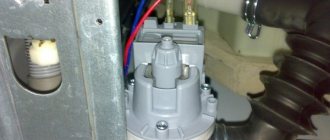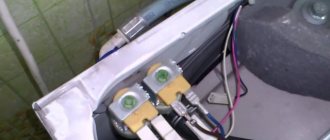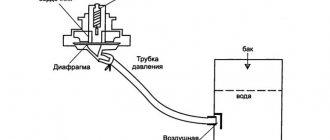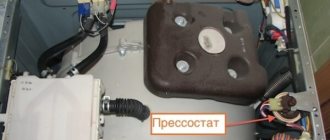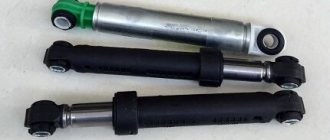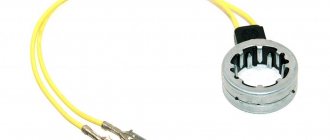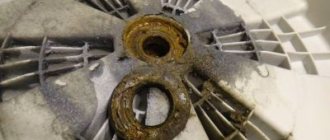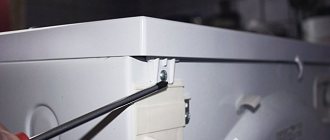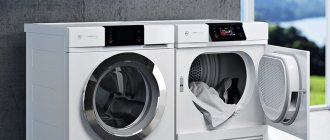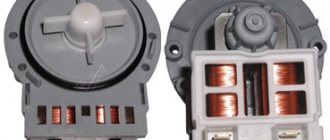If your washing machine stops working, the reason may be a faulty motor. Before buying a new part, you need to check the SMA motor and determine the cause of its failure. In most cases it can be repaired.
In the article we will look at what types of engines there are and what is special about checking them yourself.
How to check serviceability
In the assembly of washing equipment, only inverter (direct drive) and collector units are used. To determine their condition and identify a possible problem, it is worth familiarizing yourself with the diagnostic process step by step. First, let’s figure out how the components of the “heart” of the machine work:
- The stator is made of iron plates with copper windings between them. This part is stationary, but causes the rotor to rotate under the interaction of its magnetic field with its own.
- The rotor consists of a commutator, a core, and a winding. The element acts on the brushes, which transmit voltage to the commutator.
- A tachometer is installed on the housing. It records the speed of revolutions and transmits information to the main module. As a result, the module controls rotation depending on the selected washing mode.
Asynchronous type
This unit is no longer installed in modern washing machines because its efficiency level is not high. It has a simple but reliable design, so it rarely fails. Carrying out home diagnostics is not easy because the mechanism is directly attached to the drum. Frequent causes of failure are bearing wear, motor winding breakage, and insulation failure.
To make diagnostics, the asynchronous unit is removed from the housing, having first disconnected the machine from the network. Further:
- unscrew the screws;
- using a pencil, make marks on how the covers should be positioned relative to the body;
- unscrew two bolts and remove the fan;
- remove the engine covers after unscrewing the screws;
- first inspect the rotor: if it has melted or blackened, a spare part needs to be replaced;
- the motor breaks down when there is an interturn short circuit in the stator (visible by the burnt-out insulation varnish). If no damage is detected during a visual inspection, then the mechanism is checked with a multimeter, which shows the integrity of the working and starting windings. When the device shows even minimal resistance, this is a sign of winding breakdown. In such a situation, the spare part will have to be returned to a service center.
Direct drive type
It is not easy to detect a malfunction on your own. It is recommended to use system tests if they are supported by a specific machine model. When checking, codes appear on the display, deciphering which will help identify the breakdown and understand whether the help of a service center technician will be useful.
If you need to remove the motor for a detailed inspection, the diagram of this procedure will look like this:
- Disconnect the device from the power source.
- Unscrew the bolts around the perimeter of the case and remove the back cover.
- Remove the screws under the rotor that hold the wiring.
- Remove the central bolt that holds the rotor. To prevent the latter from moving, hold it with your hand when unscrewing the bolt.
- Remove the rotor assembly. Behind it is a stator assembly with 6 bolts.
- Unscrew the fasteners from the stator and disconnect the wiring connectors.
- After this, inspect for faults using the example of an asynchronous mechanism.
Collector view
The centrifuge motor of a semi-automatic or automatic washing machine operates on a belt drive with a drum and is easily removed from the housing. Installed on Ariston, Indesit, Samsung, Zanussi, Atlant units. The following scheme is used for diagnostics:
- Unscrew the back/front wall (depending on the modification of the washing machine).
- Remove the motor from under the tank. The electrical component of the unit is on terminals that can be easily opened.
- Now you need to connect the rotor and stator in series, and then apply a voltage of 220 V to the ends. If the unit is working and the automatic transformer heats up slightly, this indicates that there are no problems.
- For diagnostics, an autotransformer with a power of more than 0.5 kW is used. If you power it through the stator and rotor windings, the procedure will be safer (speed control).
The motor is the main component of the washing machine, so checking it should be taken seriously. If the diagnosis is performed incorrectly, this will entail a complete replacement of the mechanism. If a breakdown is detected, it is better to contact a service center for help.
Badly
Interesting 1
Super 1
How to diagnose an electric motor at home?
The easiest way to check for proper operation is the commutator motor. It is easier to remove it at home and can be checked without the use of expensive professional equipment.
As for electric motors with direct drive, a control system is needed to diagnose them, and it will have to be removed along with the tank, since it is an integral part of it. The stator is bolted to the frame of the automatic washing machine itself; the rotor also has a rigid mount, which in most cases is not dismountable. Repair of such washing machines is most often carried out only in service centers.
How to check a direct drive motor?
Most often, such an engine can only be checked by analyzing the errors displayed on the display or the service menu of the washing machine. Using the error code that appears on the display, you can detect a turn short circuit, diagnose a power supply break, or brush failure.
More complex and professional testing and repairs are carried out by qualified craftsmen using special laboratory and bench equipment.
How to check a commutator motor?
The most common motor used in modern models of washing machines. You can check the commutator motor of your washing machine yourself at home. First, the electric motor must be removed from the machine body. First, the back or front wall of the case is unscrewed (depending on the model of the washing machine). The motor itself is located under the tank on the rear side and is attached to the metal frame with studs or bolts. The electrical connection is equipped with terminals that can be easily opened.
After the motor is removed, it is necessary to make a series connection between the stator and the rotor, and apply a mains voltage of 220 W to the ends. It is best if it is supplied through additional ballast. You can use a heating element as it, the main thing is that the power of the equipment with active resistance is at least 500W. If, after connecting to the mains, the motor rotates and the autotransformer does not heat up much, at this stage it is possible to diagnose the normal operation of the motor.
Types of engines and causes of their breakdown
Washing machines use three types of motors. This:
- Asynchronous. Used in old style washing machines.
- Collector. Installed in all washing machines.
- Inverter. Used only in the most modern models.
An inverter or direct drive electric motor is the most difficult to check due to the assembly features. A system with such a drive is equipped with self-diagnosis, which, if the motor malfunctions, will display an error code on the display. If this does not happen, then you can inspect the device yourself.
The structure of asynchronous and commutator motors is similar. To check them, you will also need to disassemble the CM and remove the motor. The most common problems that occur in collector systems are:
- With brushes. The soft graphite material will wear out over time, especially if you have overloaded the machine frequently.
- With slats. Due to a short circuit in the network or overvoltage, the lamellas on the collector peel off.
- With windings. An interturn short circuit or open circuit could occur in the stator and rotor windings.
Therefore, if the engine on your car does not turn on, proceed to disassembly and inspection.
Inverter type
Direct drive motors can be found on SMA LG and Samsung models.
You can remove the inverter motor yourself for inspection, but it is impossible to repair it yourself if it is faulty.
- With the machine disconnected from power, unscrew all the bolts around the perimeter of the rear panel.
- To remove the motor rotor, remove the screws securing the motor wiring.
- While holding the rotor stationary, remove the central bolt.
- After removing the rotor assembly, unscrew the bolts around the perimeter of the stator assembly.
- After removing the stator, disconnect its wiring.
During inspection, did you find burnt parts? Contact the service center. If you need to replace the motor winding, it will be easier to buy a new one.
Collector type
This type is used in washing machines of the Indesit, Kandy, Samsung, Ariston, Veko, and Electrolux brands.
To check the commutator motor of the washing machine, you need to get close to it:
- Removing the rear panel reveals the engine underneath the tank.
- Note or photograph the location of the wiring and disconnect it from the motor.
- Unscrew the mounting bolts and remove the motor from the housing.
Brushes
The brushes rub against the rotor and therefore wear out. Then contact is lost and the motor circuit breaks. At the same time, the engine begins to lose power, run jerkily, start and stop.
If you notice sparking when connecting the motor to the network, this may indicate problems with the brushes or lamellas. We described methods for checking the engine in previous articles.
- On the sides of the body you will find protruding elements - brushes.
- Unscrew their fastening element and remove it from the housing.
- If they are worn out, replace them in the reverse order.
Even if one brush is worn out more than the other, both parts need to be replaced. Otherwise, this will lead to uneven impact on the rotor and operational problems.
Lamels
During long-term use, the brushes are wiped in the lamellas of the commutator cavity. Also, the lamella may peel off because the rotor is shorted or jammed. You can understand this during a visual inspection. If burrs or irregularities are observed, the anchor is removed and installed on a lathe for grooving.
The gaps between the lamellas are cleaned. To check them, test the gaps with an Ohmmeter. If the device shows a short circuit, it means you need to clean it harder.
You can determine if the lamellas are faulty by turning the rotor. A loud noise indicates a breakdown.
Bearings
Worn motor bearings result in friction between the stator and rotor. Inspect the rotor: if it begins to wear out, it needs to be replaced along with the bearings. When turned, the rotor will rotate unevenly, making scratching sounds.
To remove the bearing from the motor, you will need a special puller. It is selected depending on the size of the bearing. When installing the puller, focus on the inner ring.
To fit the bearing onto the shaft, you can heat it with a blowtorch. After cooling, it will sit firmly in place.
Windings
When the stator and rotor windings are shorted or broken, the engine loses power, hums, but does not turn. If the motor overheats and the thermostat trips, the washing machine will not work and the wash will not start.
The windings are checked with a multimeter - check the wiring and lamellas. It is impossible to reinstall the winding if it malfunctions with your own hands. Therefore, it is easier to replace the SM motor.
Now you know what to check if the engine does not start. Operate the machine according to the instructions, then all its parts will last much longer.
Diagnosis of tachometer malfunction
How can a simple user understand that there is a malfunction with the Hall sensor? External signs:
- The machine suddenly changes the drum rotation speed.
- Insufficient number of revolutions for high-quality spinning of laundry.
- When washing, the drum rotates faster than expected.
But before diagnosing a breakdown, you need to know how to check the tachogenerator in a washing machine. To do this, you will have to remove the SMA engine, so first we will rule out more likely problems:
- Look at the control panel. Find the spin key there and check to see if it is stuck, which is what caused the problem.
- Restart the washer. Unplug it for 15-20 minutes, then turn it on. If nothing has changed, then the tachogenerator needs to be checked.
Progress
Let's start with disassembling the SM:
- Disconnect the machine from the network and communications.
- Remove all screws around the perimeter of the rear panel.
- Remove it and set it aside.
- Now remove the drive belt.
- Pull it towards you while turning the pulley.
Proceed to dismantle the electric motor:
Mark the wires leading to the motor to ensure a good connection in the future.
Remove the bolts holding the engine. Loosen the motor back and forth and remove it from the housing.
Now inspect the Hall sensor in the washing machine: as a result of strong vibrations, its fastening may have become loose, or the contacts may have come loose. In this case, you just need to restore the connections and tighten the fastening bolt.
If everything is in order, you need to check the resistance of the washing machine tachogenerator. There are two ways to do this:
- Set the tester to resistance measurement mode. Unclench the wire connectors and remove them from the sensor contacts. By applying the tester probes to the contacts, check the resistance value. During normal operation, the resistance of the tachometer should be in the region of 60-70 Ohms.
- Now switch the tester to measure voltage. You need to understand whether the device produces current or not. If it does, then the tachogenerator is working. To check, apply the probes to the sensor contacts while turning the motor by hand. If the values change (approximately 0.2 Volts), then the part is working.
Be sure to check the integrity of the wiring, since the tachogenerator itself rarely breaks down. Perhaps the cause of the malfunction is in the control board - in this case, it is better to contact a service center.
Now you know what a tachometer is. To diagnose it yourself, we advise you to watch a video on the topic:
Source
What you need to consider when connecting motors from different types of washing machines
The washing machine is connected to the electrical network in accordance with “PUE 7. Electrical Installation Rules”.
Connection diagram of the washing machine to the electrical network PHOTO: 1stiralnaya.ru
Even a superficial acquaintance with the structure of the machine and its electrical circuit ensures its more conscious operation and the ability to minimize the number of emergency situations. A schematic electrical diagram is a graphical representation of the main electrical components of a machine and the connections between them.
There are three types of electric motors in washing machines.
Asynchronous
Most washing machines from previous years use three-phase asynchronous motors, each of which consists of a stationary stator and a rotating rotor. The alternating current initiates a rotating magnetic field in the stator winding sections, which induces a current in the rotor. This secondary induced current interacts with the magnetic field of the stator, and a rotating force begins to act on the rotor, due to which it begins to rotate and transmit its rotation to the devices connected to it.
Engines of this type are simple in design, unpretentious in maintenance, and reliable in operation. The main disadvantages are large starting currents and difficulties in regulating the rotation speed.
Reversible connection diagram for an asynchronous motor with a starting winding PHOTO: elektt.blogspot.com
Collector
In commutator motors, the windings are located on both the stator and the rotor. Current is supplied to the rotor through a device called a “collector,” which consists of lamellas attached to the rotor shaft and two “brushes” that are stationary relative to the stator.
Connection diagram for commutator motor PHOTO: elektt.blogspot.com
The commutator motor operates on both alternating and direct current. Here it is easy to regulate the speed by changing the supply voltage. As an industrial device, you can use a dimmer from the lighting system that is suitable in terms of power.
Inverter
An inverter motor in a washing machine is the most modern solution. The principle of operation is that in the built-in inverter, the alternating current of the electrical network is converted into direct current, and then again into alternating current of the desired frequency, which determines the speed of rotation of the shaft. It, unlike the commutator type, has no brushes and makes less noise. No brushes - no wearing parts, so nothing needs to be replaced regularly. But you have to pay for an inverter; such a machine is more expensive.
Differences between electric motors
The differences between electric motors by type are given in their descriptions. The asynchronous motor is the simplest in design. The collector has the ability to easily adjust the rotation speed. And the inverter motor is directly connected to the drum shaft without belts and gears. In short, more modern engines make less noise and are subject to speed control, but are more expensive.
Engine types
The following types of motors are most often used in washing machines:
Let's take a closer look at each type of engine and how to check its serviceability.
Asynchronous motor
This motor has been used in washing machines before. It does not have high efficiency and therefore is almost never used in modern machines. Compared to modern electric motors, it is the simplest and most reliable, and therefore breaks down much less frequently than other types of motors.
It is quite difficult to check the serviceability of this type of engine at home. It is directly connected to the drum. But if, nevertheless, you manage to get close to it, then you need to know that most often the engine breaks down due to wear of the bearings. There are two of them in the electric motor.
With their help, the rotor shaft rotates. Also common, but less common, is winding breakage. If the washing machine is stored and operated incorrectly, you may encounter a motor defect such as a violation of the insulation of its windings.
The first thing to do is make a visual inspection. This applies to all types of engines
It is necessary to pay attention to the integrity of the paint on the engine body. Its absence in some places may indicate excessive heating of the motor.
A visual inspection of the engine is best done by disassembling it.
The procedure for disassembling an asynchronous motor:
- unscrew the screws;
- make marks with marks, the location of the covers relative to the body;
- remove the fan by unscrewing two bolts;
- Remove the front and rear engine covers by first unscrewing the screws.
The rotor needs to be inspected. Upon inspection, you can identify damage associated with melting or blackening. In this case, the rotor must be replaced. Next, the stator is inspected. Upon inspection, you may find faded insulating varnish. This may indicate an interturn short circuit. The winding in this case requires rewinding. But it is better to replace the entire part.
If a visual inspection does not bring any results, you need to use a multimeter to verify the integrity of the windings. The starting and operating windings must be checked. An asynchronous motor from an old washing machine has three outputs. All windings are checked among themselves, as well as with the housing. If the device shows at least some resistance, it means there is a breakdown of the windings. In this case, the engine is submitted for stationary repair to rewind the windings. These are the main methods for checking an asynchronous motor at home.
Brushed motor
The electric motor is often used in modern washing machines. It has a belt drive with a drum and is easily removed from the unit, so checking the serviceability of the engine is not difficult.
The motor should be removed from the washing machine body by first unscrewing the housing wall. It is usually located under the tank. After removing the motor, the rotor and stator are connected in series.
A voltage of 220 Volts is supplied to the ends of this electrical circuit. For safety, a load element greater than 500 Watts should be connected in series to the circuit. To do this, a heating element or some powerful heating element is connected in series to the circuit. This inclusion will prevent the motor from complete failure in the event of a short circuit in the windings.
During the spin cycle the program freezes or the function does not work
The reasons for the lack of spin can be either mechanical or software at the level of control electronics. To exclude a breakdown at the electronics level, you need to run the spin function separately and see if fault codes appear on the control panel of the washing machine. If the machine has a touch control and a large screen, then a failure of the function will be accompanied by the symbols “ERROR”, followed by a digital error code. The analog control system is a little more complicated. It is represented by indicators that, when an error occurs, begin to glow or flicker.
One of the most common reasons for the failure of the spin function is the failure of the tachometer sensor or a break in the wires transmitting the control signal from the tachometer to the engine. In this case, DIY repairs seem to be quite problematic. Since it is necessary to have professional testing equipment.
Tachometer sensor
Mechanical causes of failure or poor performance of the spin function can be eliminated independently:
The belt transmitting torque from the motor to the drum has stretched. This problem occurs especially often in compact (narrow) washing machines.
Drive belt
Wear on engine brushes occurs during intensive use over a long period of time. At the same time, the washing machine works quite successfully at low speeds, but for spinning (maximum speed) the power is no longer enough.
Remove the electric motor
Remove the brushes
To replace the brushes, you need to remove the engine and find the brush holders on it (they may look different for different models), remove one of the brushes and purchase similar ones in the store. The need to replace brushes can be determined by the size of their protrusion from the brush holder. If at least one of them has less than 7 mm, then both cheeks need to be replaced.
Connecting a new part
Installing a new motor with your own hands will not be difficult if you strictly follow a certain sequence of actions:
- We insert the engine precisely selected in terms of power, mounting shape and other technical parameters with bushings into the seats, and fix the housing with fasteners.
- We connect the wiring of the power unit (photos or video notes taken earlier will come to the rescue).
- While turning the pulley wheel, carefully tighten the drive belt.
- We install the back panel in its original place and secure it with the mounting bolts.
After the washing machine body is assembled, the device is connected to communications, the power cord is inserted into the socket, and a test wash is started.
Kinds
The first thing you should do before starting diagnostics is to determine what type of motor is installed in your washing machine. There are several types of motors that manufacturers use to equip washing machines. Let us present brief information about them in the form of a table.
Asynchronous washing machine motor
Commutator motor of a washing machine
Brushless washing machine motor
| View | Main design elements | Advantages | Flaws |
| Asynchronous | starter and rotor |
|
|
| Collector | starter, rotor, tachogenerator, electric brushes |
|
|
| Brushless (direct drive) | starter and rotor |
|
|
Verification methods
There are two ways to independently check the health of the washing machine motor. In order to be able to use them, you need to have at least a basic understanding of the structure of the engine and how it is powered. On the Internet you can find many diagrams that display this important information in an accessible form.
Related article: DIY round bed: manufacturing sequence (video)
- The first test method involves applying voltage to the starter and rotor windings of the engine, after first connecting these elements alternately. The disadvantage of this method is that it does not guarantee a 100% result, since even if the motor rotates under voltage, this does not mean that it will function properly under different operating modes of the washing machine.
- The second method will require special equipment, namely an autotransformer with a power of 500 watts or more. Using this device you need to power the connected windings of the starter and rotor. This method is safer as it allows you to keep the speed of rotation under control.
Solving the problem with the activator
Some problems are caused by a faulty activator in the car. Leaks can occur due to improper connection of equipment or wear of O-rings and various rubber bands. But don't get ahead of yourself
It is important to first understand what an activator is
This is a movable element, due to the rotation of which washing occurs. Impaired mobility leads to a stop in the work process. Sometimes the thermal relay is triggered and the machine simply turns off. Before making repairs, you should familiarize yourself with the main problems caused by the activator. You also need to understand how to troubleshoot such problems.
So, if the tank is overloaded, then the activator will not spin normally when starting. He may even stop altogether. The machine will start humming, and the solution to the problem will be to unload it. After this, you need to wait about 15 minutes and restart. Repairing the Malyutka washing machine may involve simply removing threads and foreign objects, as well as rags from the shaft. It is part of the activator.
If the machine starts to hum and then turns off, then the repair consists of cleaning the shaft. Sometimes it happens that the node being described turns out to be skewed. It continues to spin, but after washing the laundry is often severely wrinkled or even torn.
When the activator touches the walls of the tank, you will hear a strong hum. The machine may turn off for no apparent reason. The solution is to unfold the device and remove the plug. The activator is unscrewed, and then the thread is cleaned. The assembly is again installed in place until it stops. After this, the device should work properly.
Removing and testing the motor
Almost everyone can check the engine of a Bosch washing machine, but before starting work it is recommended to get acquainted with the “object”. All Bosch models are equipped with compact and powerful brushed motors, which, unlike inverter motors, require a drive belt. An elastic band connects the drum pulley and the engine, allowing the mechanism to unwind.
The internal structure of the motor consists of a rotor, stator and winding. Electric brushes are attached to the body, and next to them is a tachogenerator that controls the acceleration speed. Having become familiar with the design of the engine, you can begin to check it. But before testing, you will have to remove the device from the washing machine.
Before disassembling the washing machine, read the factory instructions and electrical documentation.
Then we move on to checking the motor. We throw a wire from the rotor winding to the stator, and then apply a voltage of 220 Volts to the circuit. The start of rotation of the engine will indicate the operability of the unit, the lack of reaction will indicate that a breakdown has occurred.
Testing an engine with voltage also has its drawbacks. For example, in this way it is impossible to test the ability of the motor to operate at different speeds. The second “minus” is a high risk, since a direct connection is fraught with overheating of the device, followed by a short circuit. True, you can reduce the likelihood of damage to the electric motor by connecting a heating element, which will heat up when a current leaks, thereby protecting the engine.
Engine testing is not limited to just one check. It is also necessary to evaluate the condition of the electric brushes, lamellas and windings.
Pros and cons of the profession
pros
- The master receives a very good income.
- Different formats of work and profit are possible: private customers, piecework payment, service center or manufacturing companies.
- There is enough work both in megacities and on the periphery.
- You can quickly complete initial training, which lasts 3-4 months.
- The opportunity to take courses at the employer’s company, which allows you to gain knowledge, a number of practical skills and subsequent stable orders.
Minuses
- The master is not protected from unforeseen situations and claims from clients.
- The working day may be irregular.
- Possible unfavorable working conditions.
Are the graphite brushes intact?
First of all, we check the electric brushes that are located on both sides of the body. Without them, the commutator motor would not be able to work in any way. Carbon tips are subject to frictional forces and therefore tend to fail relatively quickly. To check them, you should follow the instructions.
- Unscrew the bolts holding the brushes.
- Compress the spring and remove the electric brushes.
- We take them apart to evaluate the tips. If the length of the carbon tip becomes less than 1.5 centimeters, then it’s time to replace them.
Over time, electric brushes wear out and become unusable, so they should be carefully checked and replaced in a timely manner. These parts are always replaced in pairs, even if only one electric brush is damaged. Take damaged brushes with you as an example so you can purchase the same or similar ones. For installation, the above instructions are suitable, implemented in reverse order.
The windings are broken or shorted
Acceleration problems also arise when the winding is damaged: the motor does not start or the drum rotates very weakly. The fact is that short circuits occur in the wire turns, the engine begins to overheat, the thermistor is triggered, and the system urgently turns off the power for safety reasons. At the next start, the situation repeats until the temperature sensor burns out, and then the engine itself fails.
The winding is checked with a multimeter according to the following algorithm:
- turn on the tester in the “Ohmmeter” mode;
- we attach the probes to the adjacent lamellas;
- We evaluate the resistance (the norm is from 0.1 to 0.4 Ohms).
Repairing the winding yourself is very dangerous. It is better to turn to professionals or purchase a new engine.
Share your opinion - leave a comment
Winding insulation test
The operational reliability of the electric motor is determined by the state of the insulation.
Vibration of a running engine, thermal and chemical processes worsen the electrical insulating properties. Therefore, when diagnosing after repair, you need to test the insulation in an electrical laboratory. There is a test transformer, the secondary increased voltage of which is supplied between one of the windings and the remaining coils connected to the motor housing. Test voltage values:
| Electric motor power, kW | Test voltage, V |
| Up to 1 | 500+2Unominal |
| From 1, for a nominal voltage of 100 volts | 1000+2Un, but not less than 1.5 kV |
When checking an electric motor with a 380-volt multimeter, you need to take into account that the work is carried out with the mains disconnected. Working with electricity requires composure and attention so as not to receive an electric shock. By following safety precautions, checking the serviceability of the unit is quite simple.
Carrying out disassembly
If you are wondering how to disassemble the Malyutka washing machine, then first you must remove the plug from the hole located in the back of the electric motor casing. The oblong hole of the impeller must be aligned with the hole in the casing. Through it, a screwdriver is inserted into the engine rotor. The activator is unscrewed.
You must insert a key into the hole in the activator housing and unscrew the housing. This will allow you to disconnect the tank. Disassembling the Malyutka washing machine at the next stage involves unscrewing six screws. Next, you can remove the flange and unscrew the locknut, as well as the rubber nut. They fix the switch. Now you can remove the washer and unscrew the screws that hold the casing halves together. Below it is an electric motor and other equipment elements.
Adviсe
- Once every six months to a year, check the lubrication condition of the motor bearings. If it is running low, clean the shaft of any remaining old lubricant and add new one. Do not use industrial oil - it dries quickly at 50-80 degrees.
- Do not overload the car by driving it to the limit. If the model provides 7 kg of laundry, load it by 5-6 kg.
- Reduce speed during spinning, especially when there is a lot of laundry (around a certain weight). Instead of 1000 rpm, it is better to use 400-600.
- Light items require a refreshing wash - one main cycle, one rinse, one spin. Do not delay washing for 3 hours when the laundry is lightly soiled. If you have a dryer and an iron, you don’t have to use the drying and light ironing mode.
- Secure the machine by placing it in a small recess, “sinking” the legs into the floor a centimeter. At high speeds it will not budge.
- Do not hang the SMA on brackets above the floor, even if the wall is made of reinforced concrete. If you catch the resonance when shaking while spinning clothes, you can fill up the house.
- If the supply voltage in your network changes frequently, use a high-power stabilizer or UPS that produces a stable 220 volts.
- When checking the engine for operability, turn it on in series through the heating element of the machine - the faulty windings will be saved, since if they have low resistance or short circuits, the spiral of the heating element will quickly heat up.
- An additional circuit breaker must be used in the wiring (line) of the socket into which the SMA is plugged in.
A washing machine, like any appliance, needs careful handling and timely maintenance. Then it will work for 10-20 years without any problems.
For information on how to check the washing machine motor, see below.
Source
The most common causes of engine failure
- Failed electric brushes;
- Broken winding in the rotor and stator;
- Collector lamellas.
Replacing electric brushes
These are conductive graphite cubes with wires that rub against the commutator.
The reason for replacing motor brushes may be:
- loss of rotational force of the drum or its complete stop;
- unusual noise when the washing machine is operating.
The most common cause of failure is tank overload. Also, electric brushes wear out quickly when spinning at maximum speed or due to a short circuit in the turns of the electric motor winding, a problem with the belt that connects the motor to the drum, it can jump off the pulley or break.
A visual inspection of the brushes will also help you understand the need for replacement. If they spark during operation or there is a black coating on the surface, the parts need to be replaced.
Of course, this is an inexpensive engine element, and repairs can be done at home. It is enough to purchase a suitable brush model from a specialized store or service center. The main thing is to choose and replace the brushes on the washing machine correctly; they must fully match the type of motor and it is better if it is an original set from the washing machine manufacturer.
Slats need replacement
This is precisely the component of the commutator along which the electric brushes slide. They transmit current through the rotor winding to the motor. The plates themselves are rarely subject to wear; the cause of failure can be the breaking of the cord in the winding in the places where the lamellas are attached or their detachment.
This happens, most often, also due to improper operation of the device, for example, in a top-loading machine, the washing process was started with the drum flaps open or failure of the bearings.
If the delamination is small, repairs are made on a special machine by grooving the collector. At home, you can get by with simple fine sandpaper. The principle is the same - the lamellas are sharpened, then the space between them is thoroughly cleaned of dust and shavings.
You can check the electric motor for this malfunction by slowly turning the rotor; if a characteristic sound appears, then most likely the reason is in the lamellas.
Open circuit or short circuit in the rotor or stator winding
These are the most common causes of loss of engine power or complete cessation of its operation, which can be a consequence of:
- overheating of the motor housing resulting from short circuits in the winding. The normal temperature should not be higher than 80 degrees; if it rises to 90 degrees, the thermostat is triggered, stopping the engine;
- winding insulation failure. In this case, repairs at a service center are inevitable. Most often the entire engine has to be replaced. Re-winding at home is not recommended.
A break in the winding can be detected using a multimeter in the mode of measuring the resistance between the lamellas. The norm is 0.1-0.4 Ohm.
A breakdown or short circuit in the electric motor of a washing machine can cause a malfunction and failure of other parts of the device, for example the command device (another expensive part of the machine), power triac, and reverse relay. As you can see, the most common causes of breakdowns are non-compliance with operation instructions or instability of the electrical network. To increase service life, it is recommended to use the device according to the instructions, and to protect against power surges, install a circuit breaker and connect the washing machine only through this protective device.
- 10 best ATLANT washing machines according to customer reviews
- 10 best built-in washing machines
- 10 best washing machines under 15,000 rubles according to customer reviews
- 10 best washing machines under 25,000 rubles according to customer reviews
- 13 best washing machines from 40,000 to 50,000 rubles according to customer reviews
Main causes of electric motor malfunction
The main reasons for a washing machine motor failure may be as follows:
- Malfunctions of the collector lamellas,
- Breaks in rotor and stator windings,
- Worn motor brushes.
Lamella malfunctions most often occur due to short circuits in the windings.
Broken lamellas
Due to breakdowns, the lamellas may lose contact with the rotor winding section. They can also heat up too much and even peel off. The lamellas are fixed to the collector with an adhesive. And the electrical connection with the sections of the rotor winding is created by special hooks. One of the most common failures of this engine part is the breaking of the cord in the rotor section at the junction with the lamella.
It is much worse if, due to excessive heating, the lamella has peeled off. Such a breakdown occurs due to short circuits in the winding sections, between the lamellas and rotor jamming. This defect occurs because electricity passes through the lamellas significantly above the operating level.
This can happen when the bearings jam or when a top-loading washing machine starts washing with the drum flaps not locked in the closed position. More often than not, this defect in the lamellas tells us that there are some other breakdowns of the electric motor or that the machine is not being operated correctly.
Minor delamination, not exceeding half a millimeter, is removed by grooving the collector on a special machine. After this, you need to carefully inspect and clean all parts of the part from dust and chips and remove burrs.
In order to determine the presence of this malfunction, you can slowly rotate the rotor with your own hands. If you hear a characteristic cracking sound, then most likely there is a problem.
Worn motor brushes
If the washing machine motor brushes are worn out, then it’s time to replace them with new ones. You can find new brushes in specialized stores. They can also be purchased to order. The easiest way to find suitable parts for a washing machine is to use search engines on the Internet. In Google or Yandex search results you can find organizations that sell these spare parts. And by calling them, you can find out if the brushes you need are in stock or place an order for them.
By the way, quite strong sparking can occur when the brushes are still new and have not gotten used to the internal parts of the engine. Another reason to decide that the brushes are worn out is incomplete rotation of the machine drum. Quite often this happens when there is a problem with the drive belt. For example, when it breaks or slips off a pulley. Also, the cause of what is happening may be a short circuit between the turns of the engine winding.
In most cases, brushes from other motors will not work. It is necessary to purchase brushes designed specifically for your motor.
The hardness of the brushes can affect how long they will last. But very hard brushes can damage the commutator over time.
Short circuits and breaks in rotor and stator windings
Has the engine become less powerful? Short circuits occurring between the turns of the winding are possible. As we already wrote above, in the event of such a breakdown, the drum of the machine may not rotate or may not rotate completely.
Has the electric motor stopped working? Most likely, there was a break in the stator windings. This can also happen due to too much heating of the motor housing due to short circuits in the same motor windings. If the engine has heated up to a temperature of over ninety degrees, a special thermostat designed for protection will operate. The normal temperature during operation of the electric motor should not exceed eighty degrees. As you have already read above, if the engine overheats and short circuits, the lamellas may peel off.
In addition, short circuits in the washing machine motor winding may occur due to insulation failure. Unfortunately, in this case the entire engine will have to be replaced. Or re-create the winding. Which is not very easy. And we don't recommend doing it yourself.
A short circuit in the engine of the machine can cause many other malfunctions. For example, the contacts of the control module connectors may become unusable, the power triac, reverse relay, etc. may fail.
How to choose?
Choosing a washing machine is an important and responsible task that requires a lot of attention and effort.
Experts recommend taking into account a number of factors.
Machine type. There are several types of automatic washing machines: frontal and vertical. However, they differ from each other in the way they load and unload laundry. Thus, front-loading washing equipment has a hatch for laundry on the outer front part of the body. At the same time, vertical machines are equipped with a hatch on top. The choice of one device or another depends solely on your personal preferences.
Device dimensions. The detailed size range of washing machines is described above. This characteristic is the most important when choosing a device. First of all, you should focus on the size of the room in which the equipment will be placed.
Drum volume. This indicator is the most important when choosing a device. So, depending on the number of people living in your house, you should choose a machine that is more or less voluminous. Load volume can range from 1 to ten kilograms. Please keep in mind that the volume of the drum affects the overall dimensions of the washing machine.
Functionality. Modern automatic washing machines are equipped not only with washing, rinsing and spinning functions, but also with a number of additional features. Such additional functions include a leakage protection system, the presence of additional modes (for example, a gentle or quiet wash program), drying, etc.
Control type. There are 2 main types of control: mechanical and electronic. The first type is characterized by the ability to set washing parameters using special buttons and switches located on the front panel of the device. Electronically controlled cars only require a mode task, and they configure the remaining parameters independently.
Washing class. There are several washing classes of modern washing machines. They are designated by Latin letters. In this case, A is the highest class, and G is the lowest. Amount of energy consumption. Different models of automatic washing machines have different levels of energy consumption. This indicator is regulated by the amount of money you will pay for the electricity used.
Price. High-quality home appliances cannot be too cheap. That's why if you see a low price, it should make you suspicious. The low cost may be due to the fact that you are dealing with an unscrupulous seller or purchasing low-quality (or counterfeit) products.
Appearance
When purchasing a washing machine, you should pay attention to its functions, safety indicators, and external design. Choose a device that will fit perfectly into the interior of the bathroom, kitchen or any other room where you will place a household device.
Automatic washing machines are devices that are real helpers in everyday life. Today, there are a large number of types and models that differ in a number of key characteristics.
For information on choosing an automatic washing machine, watch the following video.
Where to buy and at what price?
The quality of operation of the washing machine after repair directly depends on which motor will be installed. In order not to make a mistake with your choice, before going to the store you need to find out the following information:
- motor serial number,
- Name,
- model,
- number and year of manufacture of the washing machine.
The necessary information can be found on a special plate (located on the back wall of the washing machine) or in the passport of the household appliance.
It is better to buy a motor for a washing machine in stores that specialize in spare parts for Bosch household appliances. It would also be a good idea to study reviews about the selected seller (store) in advance.
This approach minimizes the risks of buying counterfeits and low-quality engines. The price for a Bosch washing machine motor varies between 2000-4500 rubles .
Repair of washing machine faults
Minimal repairs
washing machine can be accomplished by any owner or housewife. Even a child can fix a machine if the cause of its malfunction is a simple misunderstanding.
It is not difficult to understand the structure of a washing machine and understand the principle of its operation. But to eliminate serious
a malfunction, even knowing its cause, is an unsafe activity both for the owner of the washing machine and for the washing machine itself.
To carry out work of medium complexity and particularly complex repairs, special knowledge and experience are required. Serious breakdowns are repaired by a qualified washing machine repair technician.
How does a washing machine work? What kind of malfunction may occur? How to distinguish a banal misunderstanding from a serious breakdown that should be fixed by a professional?
Types and their characteristics
All motors that are found in modern automatic washing machines are divided into three types.
Collector
This motor is the most common today. Most washing machines are equipped with this device.
The design of the commutator motor consists of the following elements:
- body made of aluminum;
- rotor, tachometer;
- stator;
- a pair of brushes.
Commutator motors can have a different number of leads: 4, 5 and even 8. A brush design is necessary to create contact between the rotor and the motor. The collector power units are located at the bottom of the washing machine. A belt is used to connect the motor and the drum pulley.
Brushed motors are not as bad as they might seem. They also have positive parameters:
- stable operation from direct and alternating current;
- small sizes;
- simple repair;
- clear diagram of the electric motor.
Inverter
This type of motor first appeared in washing machines only in 2005. This development belongs to LG, which has held its position as a leader in the global market for several years. This innovation was then used in models from Samsung and Whirlpool, Bosch, AEG and Haier.
Inverter motors are built directly into the drum. Their design consists of a rotor (a cover with permanent magnets) and a cage with coils, which is called a stator. The inverter brushless motor is distinguished by the absence of not only brushes, but also a transmission belt.
The armature is assembled on magnets. During operation, voltage is supplied to the stator windings, having undergone preliminary conversion to inverter form.
Inverter power units have many advantages:
- simplicity and compactness;
- economical energy consumption;
- very low noise generation;
- long service life due to the absence of brushes, belts and other wearable elements;
- reduced vibration level during spinning even at high speeds, which can be selected for operation.
Engine types
The following types of motors are most often used in washing machines:
- asynchronous;
- collector;
- direct drive motors.
Let's take a closer look at each type of engine and how to check its serviceability.
Asynchronous motor
This motor has been used in washing machines before. It does not have high efficiency and therefore is almost never used in modern machines. Compared to modern electric motors, it is the simplest and most reliable, and therefore breaks down much less frequently than other types of motors.
It is quite difficult to check the serviceability of this type of engine at home. It is directly connected to the drum. But if, nevertheless, you manage to get close to it, then you need to know that most often the engine breaks down due to wear of the bearings. There are two of them in the electric motor.
With their help, the rotor shaft rotates. Also common, but less common, is winding breakage. If the washing machine is stored and operated incorrectly, you may encounter a motor defect such as a violation of the insulation of its windings.
The first thing to do is make a visual inspection. This applies to all types of engines
It is necessary to pay attention to the integrity of the paint on the engine body. Its absence in some places may indicate excessive heating of the motor.
A visual inspection of the engine is best done by disassembling it.
If you are not confident that you can handle this work, it is better not to take it on. All repair work on all types of engines is carried out only when they are disconnected from the network.
The procedure for disassembling an asynchronous motor:
- unscrew the screws;
- make marks with marks, the location of the covers relative to the body;
- remove the fan by unscrewing two bolts;
- Remove the front and rear engine covers by first unscrewing the screws.
The rotor needs to be inspected. Upon inspection, you can identify damage associated with melting or blackening. In this case, the rotor must be replaced. Next, the stator is inspected. Upon inspection, you may find faded insulating varnish. This may indicate an interturn short circuit. The winding in this case requires rewinding. But it is better to replace the entire part.
If a visual inspection does not bring any results, you need to use a multimeter to verify the integrity of the windings. The starting and operating windings must be checked. An asynchronous motor from an old washing machine has three outputs. All windings are checked among themselves, as well as with the housing. If the device shows at least some resistance, it means there is a breakdown of the windings. In this case, the engine is submitted for stationary repair to rewind the windings. These are the main methods for checking an asynchronous motor at home.
Brushed motor
The electric motor is often used in modern washing machines. It has a belt drive with a drum and is easily removed from the unit, so checking the serviceability of the engine is not difficult.
The motor should be removed from the washing machine body by first unscrewing the housing wall. It is usually located under the tank. After removing the motor, the rotor and stator are connected in series.
A voltage of 220 Volts is supplied to the ends of this electrical circuit. For safety, a load element greater than 500 Watts should be connected in series to the circuit. To do this, a heating element or some powerful heating element is connected in series to the circuit. This inclusion will prevent the motor from complete failure in the event of a short circuit in the windings.
It is very good to carry out such a test using a special laboratory transformer. When the rotor rotates, you can preliminary, but not 100%, judge the performance of the engine, since in the assembled washing unit the engine operates under load.
